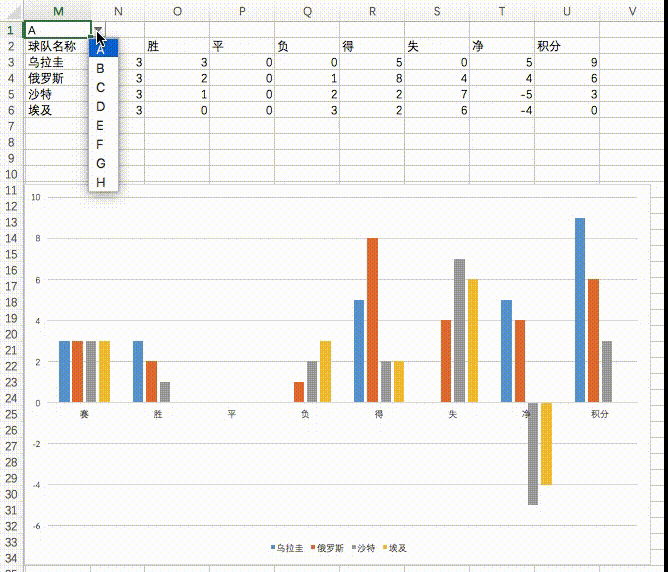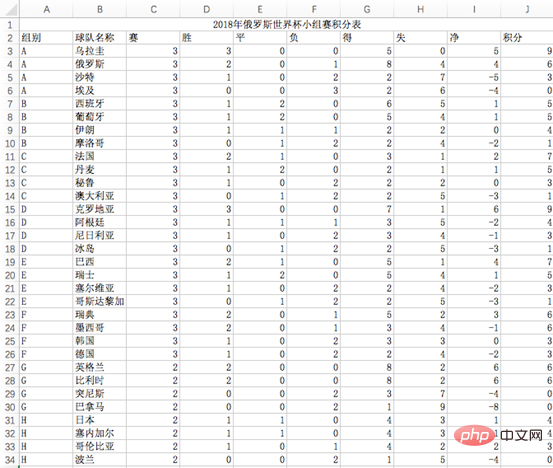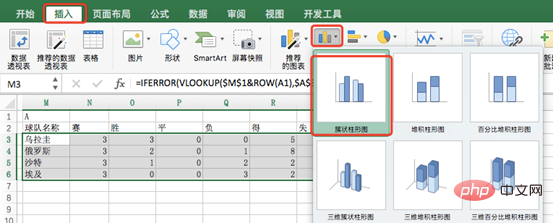Learning Excel Charts: How to Make Charts Move Like Web Pages
In the previous article "Excel chart learning through cases, talk about how to draw a graduated cylinder column chart", we learned about the method of drawing a graduated cylinder column chart. Today we will share another Excel chart tutorial and talk about a method to make Excel charts move like a web page. As long as you enter keywords, the table data and charts will automatically change. Especially when the company's data needs to be divided into departments, it is simply too confusing. Convenient!

When we browse the web, the web page will display different content according to our choices. Have you ever thought about making the excel table "enter keywords, What about a dynamic table that automatically displays corresponding data and charts? For example, when we want to make salary statistics, we use department as a keyword. Every time we enter a department name, the salary details and statistical charts corresponding to that department will be automatically displayed.
The World Cup is very popular recently. Let’s take the World Cup statistics as an example. The final effect is as follows:

1. Learning objectives
A dynamic chart is a chart that displays different information in real time based on our choices. This time we used the results of each team in the World Cup group stage as data to create dynamic charts. The original data is as follows:

The conditions that need to be met to achieve the goal are:
1. There is a drop-down box with 8 options for groups A-H;
2. Select any option to automatically display the data of the group , and automatically draw the corresponding column chart;
2. Production method
Processing Original data
After we obtain the data, we generally need to perform certain processing on the original data before it can be used as mapping data.

As shown in the picture above, insert a new column before column A to distinguish different teams in the same group. Enter the formula in cell A3:
=B3&COUNTIF(B$2:B3,B3). Double-click to fill down and you will get the result shown above.
1, COUNTTF(counting area, counting condition):
If the cells in the counting area meet the counting condition, add 1 . Analyzing the formula in cell A3, in the area B2:B3, the number of occurrences of the content (letter A) in cell B3 is returned. It can be counted once, so COUNTIF returns 1;
2. Why is it (B$2:B3,B3), not (B2:B3, B3)
We first change the formula to =B3&COUNTIF(B2:B3,B3). The final result presented in column A is as follows:

At this time, you can see that in the data in column A, only the first two teams in each group have the correct results. This is because there is no absolute reference to the cells in the counting area. When filling in the formula downwards, the counting area will automatically change the row numbers, in order B2:B3, B3:B4, B4:B5..., you will find that all counts at this time The ranges are all 2 cells, so the largest number in column A is 2.
If you want the count to accumulate, you need to lock the row number of the starting cell of the counting area, so the counting area in the formula is B$2:B3. When you drag the formula downward, the order is B$2:B3, B $2:B4, B$2:B5...
3, & The function of the symbol
& is to change the content of cell B3 Spliced together with the content returned by the COUNTTF function. For example, in the formula of cell A3, the content of B3 is "A", and the COUNTIF function returns 1, so the final value is "A1".
3. Create a drop-down box
Select cell M1, click "Data" on the menu bar, click "Data Verification", and in the pop-up Click "Data Verification" in the window

In the pop-up window, set "Allow" to the list and "Source" to "A,B,C,D,E,F ,G,H", separated by commas.

Select cell M1, and a drop-down box will appear

4. Production assistance Data
As shown below, we use area M2:U6 as the auxiliary data area, which is also the real cartographic data. Creating an auxiliary data area is also very simple. Directly copy the contents of cells C2-K2 in the source data to the cell area M2-U2, and then enter the formula in cell M3:
=IFERROR(VLOOKUP($M$1&ROW(A1),$A$3:$K$34,3 COLUMN(A1)-COLUMN($A1),0),""), right Pull down to get the table below.

Formula analysis:
IFERROR(VLOOKUP($M$1&ROW(A1),$A$3:$K$34,3 COLUMN( A1)-COLUMN($A1),0),"")
1.COLUMN (specified cell/cell range) function
its The function is to return the column number of the specified cell or cell range. As above, COLUMN(A1) will return 1;
2.ROW (specified cell/cell range) function
its function is to return the specified cell or Row number of the cell range. As above, ROW(A1) will return 1;
3.VLOOKUP (search value, search area, return value column number, 0) function
is in the M3 unit In the grid, to get the first team name of Group A, the first parameter is $M$1&ROW(A1), and the search value A1 is obtained, and the second parameter is $A$3:$ K$34 means searching in the cell range A3-K34 of the source data. The third parameter is 3 COLUMN(A1)-COLUMN($A1). Since our formula needs to be pulled to the right, So we need to find some mathematical rules. Starting from cell M3, the column numbers that need to be returned in sequence are 3 0, 3 1, 3 2, 3 3..., so the third parameter of the formula in cell M3 is
3 COLUMN(A1)-COLUMN(A1). At this time, drag one cell to the right, and the third parameter of the formula in cell N3 becomes
3 COLUMN(B1) -COLUMN(B1), at this time we have to find a way to subtract the two column numbers after 3 to get 1. Use the B1 column number minus the A1 column number to get 1, so we need to reference the second COLUMN The cell column number is locked, so the third parameter of the final formula is 3 COLUMN(A1)-COLUMN($A1).
4.IFERROR (return value when correct, return value when error) function
Its function is to define the response when an error occurs. Returns the first parameter if correct and the second parameter if incorrect.
5. Make a column chart
Select the data M3:U6, click the insert option, select the column chart, modify the chart title, and then The performance bar chart of Group A teams can be obtained as follows.

Okay, that’s it for today’s tutorial. Have you finished it? Quickly try to modify the content of cell M1 to B, and see if the data area M3:U6 will change, and whether the column chart will change automatically. If it becomes like the following, it means that the dynamic chart you made is successful~
Related learning recommendations: excel tutorial
The above is the detailed content of Learning Excel Charts: How to Make Charts Move Like Web Pages. For more information, please follow other related articles on the PHP Chinese website!

Hot AI Tools

Undresser.AI Undress
AI-powered app for creating realistic nude photos

AI Clothes Remover
Online AI tool for removing clothes from photos.

Undress AI Tool
Undress images for free

Clothoff.io
AI clothes remover

AI Hentai Generator
Generate AI Hentai for free.

Hot Article

Hot Tools

Notepad++7.3.1
Easy-to-use and free code editor

SublimeText3 Chinese version
Chinese version, very easy to use

Zend Studio 13.0.1
Powerful PHP integrated development environment

Dreamweaver CS6
Visual web development tools

SublimeText3 Mac version
God-level code editing software (SublimeText3)

Hot Topics
 1378
1378
 52
52
 What should I do if the frame line disappears when printing in Excel?
Mar 21, 2024 am 09:50 AM
What should I do if the frame line disappears when printing in Excel?
Mar 21, 2024 am 09:50 AM
If when opening a file that needs to be printed, we will find that the table frame line has disappeared for some reason in the print preview. When encountering such a situation, we must deal with it in time. If this also appears in your print file If you have questions like this, then join the editor to learn the following course: What should I do if the frame line disappears when printing a table in Excel? 1. Open a file that needs to be printed, as shown in the figure below. 2. Select all required content areas, as shown in the figure below. 3. Right-click the mouse and select the "Format Cells" option, as shown in the figure below. 4. Click the “Border” option at the top of the window, as shown in the figure below. 5. Select the thin solid line pattern in the line style on the left, as shown in the figure below. 6. Select "Outer Border"
 How to filter more than 3 keywords at the same time in excel
Mar 21, 2024 pm 03:16 PM
How to filter more than 3 keywords at the same time in excel
Mar 21, 2024 pm 03:16 PM
Excel is often used to process data in daily office work, and it is often necessary to use the "filter" function. When we choose to perform "filtering" in Excel, we can only filter up to two conditions for the same column. So, do you know how to filter more than 3 keywords at the same time in Excel? Next, let me demonstrate it to you. The first method is to gradually add the conditions to the filter. If you want to filter out three qualifying details at the same time, you first need to filter out one of them step by step. At the beginning, you can first filter out employees with the surname "Wang" based on the conditions. Then click [OK], and then check [Add current selection to filter] in the filter results. The steps are as follows. Similarly, perform filtering separately again
 How to change excel table compatibility mode to normal mode
Mar 20, 2024 pm 08:01 PM
How to change excel table compatibility mode to normal mode
Mar 20, 2024 pm 08:01 PM
In our daily work and study, we copy Excel files from others, open them to add content or re-edit them, and then save them. Sometimes a compatibility check dialog box will appear, which is very troublesome. I don’t know Excel software. , can it be changed to normal mode? So below, the editor will bring you detailed steps to solve this problem, let us learn together. Finally, be sure to remember to save it. 1. Open a worksheet and display an additional compatibility mode in the name of the worksheet, as shown in the figure. 2. In this worksheet, after modifying the content and saving it, the dialog box of the compatibility checker always pops up. It is very troublesome to see this page, as shown in the figure. 3. Click the Office button, click Save As, and then
 How to type subscript in excel
Mar 20, 2024 am 11:31 AM
How to type subscript in excel
Mar 20, 2024 am 11:31 AM
eWe often use Excel to make some data tables and the like. Sometimes when entering parameter values, we need to superscript or subscript a certain number. For example, mathematical formulas are often used. So how do you type the subscript in Excel? ?Let’s take a look at the detailed steps: 1. Superscript method: 1. First, enter a3 (3 is superscript) in Excel. 2. Select the number "3", right-click and select "Format Cells". 3. Click "Superscript" and then "OK". 4. Look, the effect is like this. 2. Subscript method: 1. Similar to the superscript setting method, enter "ln310" (3 is the subscript) in the cell, select the number "3", right-click and select "Format Cells". 2. Check "Subscript" and click "OK"
 How to set superscript in excel
Mar 20, 2024 pm 04:30 PM
How to set superscript in excel
Mar 20, 2024 pm 04:30 PM
When processing data, sometimes we encounter data that contains various symbols such as multiples, temperatures, etc. Do you know how to set superscripts in Excel? When we use Excel to process data, if we do not set superscripts, it will make it more troublesome to enter a lot of our data. Today, the editor will bring you the specific setting method of excel superscript. 1. First, let us open the Microsoft Office Excel document on the desktop and select the text that needs to be modified into superscript, as shown in the figure. 2. Then, right-click and select the "Format Cells" option in the menu that appears after clicking, as shown in the figure. 3. Next, in the “Format Cells” dialog box that pops up automatically
 How to use the iif function in excel
Mar 20, 2024 pm 06:10 PM
How to use the iif function in excel
Mar 20, 2024 pm 06:10 PM
Most users use Excel to process table data. In fact, Excel also has a VBA program. Apart from experts, not many users have used this function. The iif function is often used when writing in VBA. It is actually the same as if The functions of the functions are similar. Let me introduce to you the usage of the iif function. There are iif functions in SQL statements and VBA code in Excel. The iif function is similar to the IF function in the excel worksheet. It performs true and false value judgment and returns different results based on the logically calculated true and false values. IF function usage is (condition, yes, no). IF statement and IIF function in VBA. The former IF statement is a control statement that can execute different statements according to conditions. The latter
 Where to set excel reading mode
Mar 21, 2024 am 08:40 AM
Where to set excel reading mode
Mar 21, 2024 am 08:40 AM
In the study of software, we are accustomed to using excel, not only because it is convenient, but also because it can meet a variety of formats needed in actual work, and excel is very flexible to use, and there is a mode that is convenient for reading. Today I brought For everyone: where to set the excel reading mode. 1. Turn on the computer, then open the Excel application and find the target data. 2. There are two ways to set the reading mode in Excel. The first one: In Excel, there are a large number of convenient processing methods distributed in the Excel layout. In the lower right corner of Excel, there is a shortcut to set the reading mode. Find the pattern of the cross mark and click it to enter the reading mode. There is a small three-dimensional mark on the right side of the cross mark.
 How to insert excel icons into PPT slides
Mar 26, 2024 pm 05:40 PM
How to insert excel icons into PPT slides
Mar 26, 2024 pm 05:40 PM
1. Open the PPT and turn the page to the page where you need to insert the excel icon. Click the Insert tab. 2. Click [Object]. 3. The following dialog box will pop up. 4. Click [Create from file] and click [Browse]. 5. Select the excel table to be inserted. 6. Click OK and the following page will pop up. 7. Check [Show as icon]. 8. Click OK.







